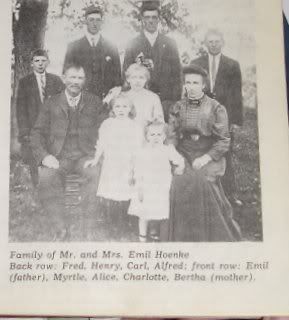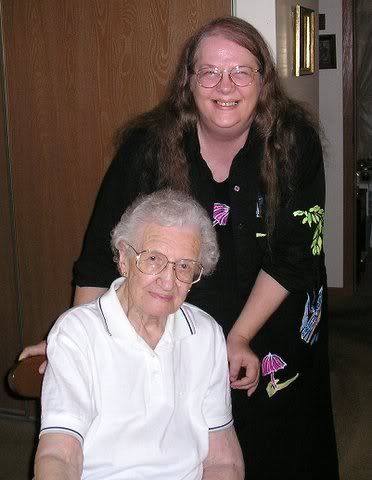This morning ... have to progress MORE!
Dear Dr. K,I wanted you to know that I am still here. I'm having trouble with the writing. I've been stuck on the assignment from 2.1. We had outlined the chapter and noted the resources that we wanted to use. Then we wrote about ten paragraphs ... and it seemed that the more time invested the more lost I became. Somehow it was turning into a paper on abuse although that was not the intention to start. It's just that the examples I was thinking to tie into attributes and such were all related to the past around the time of a separation/divorse 16 years ago. I don't usually write like that. Then in trying to understand how and what had happened to the paper we started adapting the paper to a new program called, "The Brain" suggested by the Encyclopedia Britanica.
On one side I know I'm getting in big trouble with my time, but there's this other side where the material from the unit is helping me to figure out something that was very important in my life. I took yesterday off from work and its all I did, but we're not getting "things done" as in paper.
I'll send you an attachment ... feels like being in a tail spin. Please advise. I know I can't afford to lose weekend.
Ann
Ok, this video is like 2 hours and 10 minutes, but now for just a few minutes start it up and listen to the sections 13 min - 26 min. This is the part we want to show you what we're doing with the brain. This is where we are at now.
Paper...
The process of perceiving people is through observation, attribution, integration, and confirmation (Brehm, Kassin, & Fein, 2005). The observation label is a collection of the different elements that go into first impressions, scripts, and behavioral evidence (2005). Attribution is our explanations on why things happen as they do. Attribution bias is our general personal rules, whether right or wrong as to how we perceive others (2005). Biases are affected by our cultures, cognitive heuristics and motivation. Integration is in taking the dispositional evidence we just collected to form our impressions so that we can make inferences of self and others (2005). Confirmation is the process in which our impressions form into reality even when we are wrong, and in general, our perceptions are either quick and automatic, or mindful, but not always truthful; we settle for what is comfortable or good enough (2005). The process of perception has applications in the workforce particularly in work where you need to listen to people at client, staff, and administrative levels, but perhaps more immediately for us in looking at issues of abuse.
The observations that we make come from our first impressions of the physical or emotional appearance of others (Brehm, Kassin, & Fein, 2005). Because we have all interacted with many people and situations before any one encounter, we develop scripts as to how we think people should act in various situations. For example, thinking of my childhood family script, I find myself cringing at the mere thought of intimacy with my birth family. This family script affects my perceptions when I’m at work and I see other families interacting. Often we see that people are much more loving and knowledgeable of each other than I am comfortable with. We “collect evidence to support or deny our script noticing not only the beneficial glances and touch of parents and children, but also the behaviors and body language that might give better clue to suspect motivations. I carry a certain measure of distrust that people are sincere. Each instance then of watching other families interact, I need to consciously remind our self-system that we will be ok, even though we weren’t similarly loved. It would be easy to understand then, but not excuse our need for self-deception, in order to cope with fears of not “fitting in.”
Attributions are how we make sense of how the world fits together. People with a background of abuse tend to over observe, analyze, and rationalize. They sometimes follow patterns of hypersensitivity, hyperarousal, and catastrophising. We try to second guess whether others we meet or people we know are safe to be interacting with. The attribute of anger in others becomes a trigger, which is threatening to our sense of security. It is much more likely that when we do encounter people we consider angry, we attribute their emotion to internal characteristics of them being dangerous or that we are somehow at fault and responsible for the emotion rather than perhaps the person was just in an argument or stubbed his toe, which would be situational circumstances. Inference and Covariation theories both assume that we can observe something in others’ behavior that directly represents another’s personality. With our therapist we often find ourselves questioning out loud whether or not he is mad at us. We can intellectualize that although sometimes we can be frustrating, he doesn’t really get mad at us. Still, we watch his behavior looking for conditions that will establish our internal certainty that people cannot be trustworthy and that eventually we will uncover his “true” personality, or worse yet, he will uncover ours. I can know this is wrong thinking, but still we need to battle our internal scripts.
Attribution bias relates to our rules we create to justify quick and easy interpretations of our environments. We each make up our own mythology as I will do in just a moment. In order to function socially we “estimate the odds that something is going to happen,” which is called an availability heuristic (Brahm, Kassin, & Fein, 2005) and to support this bias, we often believe that others share our opinions, attributes, and behaviors (2005). In a study completed by Daggett, O’Brien, Zanolli, & Peyton (2000), they found in examining parents’ childhood perceptions that often the attitudes and expectations were mirrored from their families of youth to their children. They stated that Mothers who reported harsh parenting as children, negative attitudes about life, and unrealistic developmental expectations had negative attitudes about their own child,” which related to a “lower quality home environment” (2000). At the beginning of this chapter and at the end, two points are highlighted - sometimes perception is quick and fairly automatic and at other times we are able to test our perceptions more carefully (2005). This fits the case of children who are or were abused. The difference it would seem between adult abused children and adults not abused would be that the adult abused in childhood would have many more negative scripts to challenge and the scripts of being “unlovable” probably affect their personality and esteem more deeply.
Because the odds seem greater that negative things are going to happen, people who have been abused often find themselves in adult relationships that continue aspects of an abusive relationship. That is the role we expect, although in adulthood we have the opportunity to establish new rules, often we are feel unequal to the task. For example, I had understood physical abuse enough to know that if I were hit once by my spouse, most likely I would be hit again. So that became a marker point to us; if it happened we would have to leave the relationship. Because I carried that heuristic, in fact, we set ourselves up inevitably to be hit. We tend to be more accepting of the negativity in relationships, because that furthered our childhood scripts. Base-rate fallacy establishes our becoming more enamored in drama, so even now 16 years after the divorce; we’re still recalling the situation of being hit although the occurrence had only been once.
We didn’t understand as concretely the rules of emotional abuse. Our spouse had told us and the doctors that he had wanted to kill us, or more preferably, we could kill ourselves, which he said would allow him to collect our life insurance. The odds of our husband killing us were quite slim we rationalized, because we were still thinking he loved us better than we could love ourselves. When he shared some of these wishes with hospital staff there was a general sense of crises. The hospital helped change our perception in that he was really a dangerous person to us. Today, we are more likely to see the situational stress of him being a young man pressured by a wife with mental illness, finances, family and new relationship with another woman. We knew we needed help with our perceptions at the time though, because that is what hospital staff was telling us and we were feeling of danger to ourselves along the lines of our family script to self-destruct. It is more common in Western societies as a whole to make attributes that place the individual in the forefront and the situation in the background as in not seeing at the time the other factors that were contributing to the relationship that had little to do with us. In general, this whole scenario is part of our “abuse bias,” or victim mentality, which included being at fault and overly responsible for the relationship. There is a new heuristic centered on self-care and an allowance of our primary needs to have healthy life structures and self-support.
Part of our thinking that we were going to maintain our marriage at the time was in our perception of not being able to take care of self(ves); we waited thinking our spouse would “come to his senses” and we could continue our marriage/dependency. At the time of the marital crisis it seems we converted our “helpless” script from our husband to the doctor and hospital; they were better caregivers and would gradually help us to take better care of ourselves. We were held for two months until safer housing could be arranged. I believe opposite to individuals who are not abused, we take more credit for our failures than our successes; we hadn’t seen the hospital’s viewpoint that a move away from our spouse was to be one of our first successes; we were only seeing the failure of our marriage and that we were to blame. Instead we attributed our successes to the new doctor who appeared safer and more able to reason clearly. He conveyed throughout he would only help us learn how to take care of ourselves. We had to form new heuristics of how the world was going to work. In the former relationship most consideration and energy was spent toward our spouse, his family, and our children, so being now the center of attention was a major paradigm shift.
In looking at integration we realize that we’d formed in others a set of dispositions that allowed us to make sense of the circumstances. Over the years we’ve looked at the situation differently so that each time it mirrors more closely our new sense of self. It allows us an impression that we were always “the good guy” and we also are allowed through time the ability to let go, so what had hurt us at the time is not hurting us the same way now. “People act as their own masters, defining their terms differently, when dealing with the words they use to describe themselves and the concepts they use to judge others” (Dunning & Cohen, (1992). In stepping away from the negative relationships, we started to see things more positively and we looked for the positive in others that were more like ourselves. We found people that were smart, which was a disposition that weighed heavily in our mind, but we also looked for people who were more compassionate and that allowed us to feel better about ourselves. Although we struggled for many years, we found people who would be supportive and emotional stable. Without realizing it, we were looking for safely not dependency.
Following along the processes of perception the next state includes confirmation biases. We turn our impressions to reality. Many years after the separation and eventually the divorce, we again found ourselves at the hospital crossing a bridge that needed to be crossed. We had available to us a very good psychiatric nurse who outlined with us briefly the difference between our past and future. Certain doors had closed, but others had opened. We hadn’t seen for ourselves how clearly the picture really was. Basically, the end conclusion was that all the roads were leading toward going back to finishing the degree. To do this, we needed to take the focus from the past (including the ex) and refocus it on our educational dreams. “Resolving traumatic attachment to the perpetrator may be the core therapeutic task complicating the process of reclaiming trust, expressing grief and anger, and developing empowered meaning attributions” (Leahy, Pretty, & Tenebaum, 2003). We were able to do this most concretely through a successful relationship with our doctor who had negotiated a therapeutic environment that was safe. School, was an extension of our need for safety. We needed to learn about people and relationships and appreciate that most teachers were safer than family had been. We leaned more heavily on this set of familiar heuristics. It also played an affect because it had been something started, but left unfinished. We needed not only the degree, but some sense of closure. Toward change-of-meaning-hypothesis, we started to look at our husband more as someone who had blocked educational doors and this in return assisted us in enrolling and taking active steps forward, because he could no longer affect us if we so chose.
We find it surprising that we’ve gone through this amount of depth from our past in trying to understand better the area of perception. Most often we hold our present life course without articulating or expressing thoughts from the past. We preserver toward more basic beliefs, like toward school, than through marriage because it allows us to feel less vulnerable. We test our hypothesis by allowing more flexibility in the work that we are doing in that we now have tools to integrate more completely our avenues or paths. We still maintain a confirmation bias in that we still want to be liked with either more or less information given. We would like to know that it is acceptable to be us and to process as we might. In summary of the written material
Pause paper ... not complete...
Outline for chapter in Social Psych
The process of perceiving people is observation, attribution, integration, and confirmation.
1. Observation - elements
a. First impressions
i. Physical appearance
ii. Name
iii. Face
b. Scripts
i. "That enable us to anticipate the goals, behaviors, and outcomes likely to occur in a particular setting (Abelson, 1981; Read, 1987).
ii. Knowledge of social settings
1. What we expect to happen
2. How we explain the causes of human behavior
c. Behavior Evidence
i. Recognize what a person is doing (at any given minute)
ii. Derive meaning from it
1. Non-verbal behavior
a. Feelings and emotions
2. Body language
3. Eye contact
4. Touch
iii. Deception (covering our emotions)
2. Attribution - elements to dispositions - The explanations we develop (observe, analyze, and explain) to manage social world
how people feel and if they can be trusted (predict future behavior by identifying dispositions (stable characteristics, which are personality traits, attitudes, and abilities) inferred indirectly from what people say and do.
a. Theories
i. Describing the process we come up with (why questions)
1. Personal
a. Internal characteristics (ability, personality, mood, and effort)
2. Situational
a. Factors external to people (task, other people, and luck)
ii. Jones Correspondent Inference Theory
1. Inferring from action or behavior whether it represents a person's personality or not
a. Degree of choice
b. The expectedness of behavior (agree with norm)
c. The intended affect of someone's behavior
iii. Kelley's Covariation Theory
1. Principle - something has to be present and directly cause the behavior
a. Consensus - does the behavior repeat in others
b. Distinctiveness - is it different from others
c. Consistency - does it remain the same
b. Biases - See study Parents' Attitudes About Children : Associations With Parental Life Histories and Child-Rearing Quality
i. Cognitive Heuristics
1. Our general social rules that are quick and easy
2. Availability heuristic - estimate the odds something will happen
3. False-consensus effect - overestimation of others sharing opinions, attributes, and behaviors
4. Base-rate fallacy - more than normal absorption in graphic dramatical events
5. Counterfactual thinking - imagine alternative outcomes that didn't happen
ii. The fundamental attribution error
1. When people overestimate personal factors and forget situational factors.
c. Cultural constructions
i. People from Western societies place more attributions on personal self; foreground
ii. People from Eastern societies place more attribution on social world; background
d. Motivational biases - See study Egocentric Definitions of Traits and Abilities in Social Judgment
i. Our social perception being colored by personal needs, wishes and preferences.
ii. We take more credit for success than failure
iii. We overestimate the extent to which others think, feel, and behave to rationalize our own social behaviors
iv. Ideological motives
1. Conservatives believe problems caused by underclass
2. Liberals believe problems caused by institutional favoritism
v. Defensive motives lead us to blame others for their misfortunes
1. Belief in a just world - you just need to work harder
2. If one can't help the other, then we blame him (more attribution on the person than the situation)
3. Integration - disposition to impression - See study Childhood Sexual Abuse Narratives in Clinically and Nonclinically Distressed Adult Survivors
a. By making personal attributions we are lead to an inference that a person has a certain disposition.
b. The arithmetic
i. Impression formation
1. Summation model of impression (if we are more impressed) is the more positive traits there are the better
2. Averaging model of impression (if we are less impressed) is the higher the average value of all the various traits the better
3. Scale value - ratings obtained for each trait (sincere/liar) - moderate ratings diluted upper and lower ratings
4. Information integration theory
a. Personal dispositions of the perceiver
b. A weighted average, not a simple average, of the target person's characteristics
c. Deviations from the arithmetic - See study The Development of Competence-Related and Motivational Beliefs : An Investigation of Similarity and Influence Among Friends
i. Perceiver characteristics
1. We each look for certain traits in others such as beauty, intelligence, warmth, etc.
2. We see in others that which we like of ourselves
3. Perceivers are influenced by their present mood
ii. Priming effects
1. Characteristics we see in other people are somewhat depended on our current situation
2. Recently practiced concepts come to mind influencing perceptions more readily
3. We are more likely to perceive others as positive when we are primed first with positive thoughts or sense of accomplishment or good deed
iii. Target characteristics
1. Extroversion
2. Emotional stability
3. Openness to experience
4. Agreeableness
5. Conscientiousness
6. Valence of trait
a. Consideration of socially desirable or undesirable to our final impressions
7. Trait negative bias - negative information affects us more profoundly than positive.
iv. Implicit Personality Theories
1. A network of assumptions that we hold about relationships among various types of people, traits, and behaviors
2. The presence of one trait often implies the presence of others
3. The presence of certain traits have more influence on final impressions.
v. The Primacy Effect
1. The order in which a trait is discovered can influence impact, especially when first makes a lasting impression
2. When perceivers come to an accurate impression, they tend to pay less attention to subsequent information
3. Need for closure - is the desire to reduce ambiguity
a. Those high in closure tend to be impatient and impulsive and form quick and lasting judgments
b. Those low in closure tend to be open-minded, deliberate and perhaps even reluctant to draw firm conclusions about others
4. Change-of-meaning hypothesis once people have formed an impression they start to interpret inconsistent information in light of that impression (remarkable how creative we are in our efforts
to transform a bundle of contradictions into a coherent, integrated impression (reconciliation))
4. Confirmation Biases - from impressions to reality - See study Realism of Confidence in Obsessive–Compulsive Checkers
a. One people make up their minds they are highly unlikely to change even when confronted with new evidence.
i. Due to personal investment
ii. Confirmation biases - tendencies to interpret, seek, and create information in ways that verify existing beliefs
b. Perseverance of beliefs
i. People form early impressions that interfere with their subsequent ability to "see straight" once presented with improved evidence
ii. We see what we want or expect to see
iii. Belief perseverance - sticking to initial beliefs (easier to build then tear down)
iv. Once people form an opinion that opinion becomes strengthened when they merely think about the topic, even if they do not articulate the reasons for it
v. By asking people to consider an alternative theory that might be true, we can reduce or eliminate the belief perseverance effects to which they (and us) are vulnerable
c. Confirmatory hypothesis testing
i. Expecting a certain kind of person, participants unwittingly sought evidence that confirmed their expectations
ii. One-sided search when people are not certain of their beliefs and are concerned about the accuracy of their impressions, when they are allowed to ask their own questions, or when available nonconfirmatory responses are better then people tend to pursue a more balanced search for information
d. Self-fulfilling prophesy
i. A perceiver's expectations can actually lead to its own fulfillment
1. A perceiver forms an impression of a target person (based n interactions or other information
2. The perceiver behaves in a manner that is consistent with that first impression
3. The target person unwittingly adjusts his or her behavior to the perceiver's actions
4. Result: behavioral confirmation of the first impression
ii. When perceivers are highly motivated to seek the truth the become more objective, do not confirm prior expectations and are not so causal with their impression making.
iii. Prophecies of power high-power perceivers triggered the self-fulfilling prophecy, the low-power perceivers did not and the low power perceivers spent more time just trying to be liked
iv. Target's often don't know how they are being perceived
1. When discovered would overcome the effect by acting in ways that forced the perceiver to change his mind
2. This was especially true if the perceiver's perception clashed with the target's self-concept
3. What changed as a result of the interaction were the perceiver's' beliefs, not the target's behavior because the perceived have their own prophecies to fulfill
e. Summary - Social Perception - bottom line - See study Informant Discrepancies in the Assessment of Childhood Psychopathology : A Critical Review, Theoretical Framework, and Recommendations for Further Study
i. Two correct assumptions
1. Perception is quick and relatively automatic
2. Perception is relatively mindful
ii. Both assumptions cause us to steer our interactions along a path narrowed by first impressions (self-fulfilling prophecy)
iii. We overestimate our accuracy of predictions
1. More so in the case of people who scored
a. Low on spelling tests
b. Low in logic
c. Low in grammar
d. and low in humor appreciation
2. Satisfying (satisfying and sufficing)
a. Our judgments are good enough
b. Bounded rationality
i. We are rational within bounds depending on our abilities, motives, available time, and other factors
ii. People seldom compute intricate probablities to make decisions
iii. Compute fast and frugal heuristics (good enough)
iv. Sometimes get fooled
c. Biases lead to harmful consequences - stereotypes, prejudice and discrimination, BUT
i. We become more accurate with experience
ii. We become pretty good at predicting how people will act directly around us
iii. People will perceive better if taught the rules of probability and logic
iv. More accurate impressions of others can come about when motivated by a concern for accuracy and open-mindedness rather than by need for immediacy, confirmation, and closure.

Sorry just thought this was cool new cars 8'x5' 40 mpg in city, 60 mpg on highway!
















